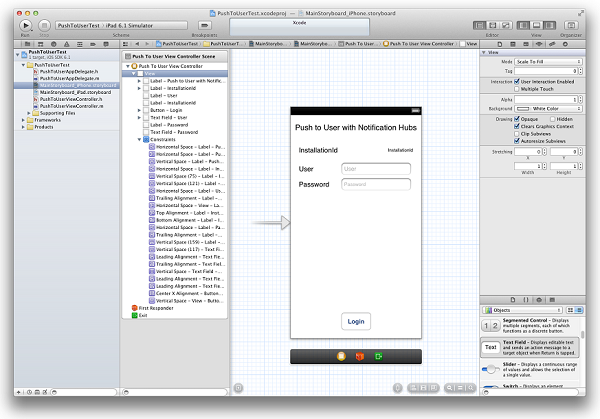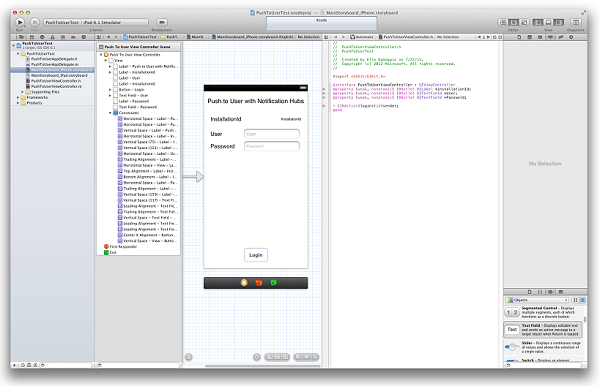ASP.NET を使用した現在のユーザーのプッシュ通知への登録
概要
このトピックでは、ASP.NET Web API により登録が実行されるときに Azure Notification Hubs を使用してプッシュ通知登録を要求する方法について説明します。 このトピックは、チュートリアル「 Notification Hubs によるユーザーへの通知」を拡張したものです。 認証されたモバイル サービスを作成するには、このチュートリアルの必要な手順を既に完了している必要があります。 ユーザー通知シナリオの詳細については、「 Notification Hubs によるユーザーへの通知」を参照してください。
アプリケーションを更新する
MainStoryboard_iPhone.storyboard で、オブジェクト ライブラリから次のコンポーネントを追加します。
ラベル:"Push to User with Notification Hubs"
ラベル:"InstallationId"
ラベル:"User"
テキスト フィールド: "User"
ラベル:"Password"
テキスト フィールド: "Password"
ボタン: "Login"
この時点で、ストーリーボードは次のようになります。

アシスタント エディターで、すべての switched コントロールのアウトレットを作成してそれらを呼び出し、テキスト フィールドとビュー コントローラー (デリゲート) を接続して、ログイン ボタンのアクションを作成します。

この時点で、BreakingNewsViewController.h ファイルには次のコードが含まれています。
@property (weak, nonatomic) IBOutlet UILabel *installationId; @property (weak, nonatomic) IBOutlet UITextField *User; @property (weak, nonatomic) IBOutlet UITextField *Password; - (IBAction)login:(id)sender;DeviceInfoという名前のクラスを作成し、次のコードを DeviceInfo.h ファイルの interface セクションにコピーします。@property (readonly, nonatomic) NSString* installationId; @property (nonatomic) NSData* deviceToken;DeviceInfo.m ファイルの implementation セクションに次のコードをコピーします。
@synthesize installationId = _installationId; - (id)init { if (!(self = [super init])) return nil; NSUserDefaults *defaults = [NSUserDefaults standardUserDefaults]; _installationId = [defaults stringForKey:@"PushToUserInstallationId"]; if(!_installationId) { CFUUIDRef newUUID = CFUUIDCreate(kCFAllocatorDefault); _installationId = (__bridge_transfer NSString *)CFUUIDCreateString(kCFAllocatorDefault, newUUID); CFRelease(newUUID); //store the install ID so we don't generate a new one next time [defaults setObject:_installationId forKey:@"PushToUserInstallationId"]; [defaults synchronize]; } return self; } - (NSString*)getDeviceTokenInHex { const unsigned *tokenBytes = [[self deviceToken] bytes]; NSString *hexToken = [NSString stringWithFormat:@"%08X%08X%08X%08X%08X%08X%08X%08X", ntohl(tokenBytes[0]), ntohl(tokenBytes[1]), ntohl(tokenBytes[2]), ntohl(tokenBytes[3]), ntohl(tokenBytes[4]), ntohl(tokenBytes[5]), ntohl(tokenBytes[6]), ntohl(tokenBytes[7])]; return hexToken; }PushToUserAppDelegate.h で、次のプロパティ シングルトンを追加します。
@property (strong, nonatomic) DeviceInfo* deviceInfo;PushToUserAppDelegate.m の
didFinishLaunchingWithOptionsメソッドで、次のコードを追加します。self.deviceInfo = [[DeviceInfo alloc] init]; [[UIApplication sharedApplication] registerForRemoteNotificationTypes: UIRemoteNotificationTypeAlert | UIRemoteNotificationTypeBadge | UIRemoteNotificationTypeSound];最初の行では、
DeviceInfoシングルトンが初期化されます。 2 行目は、プッシュ通知用の登録を開始します。これは、「Notification Hubs の使用」のチュートリアルを以前に完了していれば既に存在します。PushToUserAppDelegate.m で、AppDelegate に
didRegisterForRemoteNotificationsWithDeviceTokenメソッドを実装し、次のコードを追加します。self.deviceInfo.deviceToken = deviceToken;これにより、要求のデバイス トークンが設定されます。
Note
この時点では、このメソッドに他のコードは存在しません。 「Azure Notification Hubs を使用して iOS アプリにプッシュ通知を送信する」チュートリアルを行ったときに追加した
registerNativeWithDeviceTokenメソッドへの呼び出しが既にある場合は、その呼び出しをコメント解除するか、削除する必要があります。PushToUserAppDelegate.mファイルに次のハンドラー メソッドを追加します。* (void) application:(UIApplication *) application didReceiveRemoteNotification:(NSDictionary *)userInfo { NSLog(@"%@", userInfo); UIAlertView *alert = [[UIAlertView alloc] initWithTitle:@"Notification" message: [userInfo objectForKey:@"inAppMessage"] delegate:nil cancelButtonTitle: @"OK" otherButtonTitles:nil, nil]; [alert show]; }アプリケーションが実行中に通知を受信すると、このメソッドは UI にアラートを表示します。
PushToUserViewController.mファイルを開き、次の実装でキーボードを返します。- (BOOL)textFieldShouldReturn:(UITextField *)theTextField { if (theTextField == self.User || theTextField == self.Password) { [theTextField resignFirstResponder]; } return YES; }PushToUserViewController.mファイルのviewDidLoadメソッドで、次のようにinstallationIdラベルを初期化します。DeviceInfo* deviceInfo = [(PushToUserAppDelegate*)[[UIApplication sharedApplication]delegate] deviceInfo]; Self.installationId.text = deviceInfo.installationId;PushToUserViewController.mの interface に次のプロパティを追加します。@property (readonly) NSOperationQueue* downloadQueue; - (NSString*)base64forData:(NSData*)theData;その後、次の実装を追加します。
- (NSOperationQueue *)downloadQueue { if (!_downloadQueue) { _downloadQueue = [[NSOperationQueue alloc] init]; _downloadQueue.name = @"Download Queue"; _downloadQueue.maxConcurrentOperationCount = 1; } return _downloadQueue; } // base64 encoding - (NSString*)base64forData:(NSData*)theData { const uint8_t* input = (const uint8_t*)[theData bytes]; NSInteger length = [theData length]; static char table[] = "ABCDEFGHIJKLMNOPQRSTUVWXYZabcdefghijklmnopqrstuvwxyz0123456789+/="; NSMutableData* data = [NSMutableData dataWithLength:((length + 2) / 3) * 4]; uint8_t* output = (uint8_t*)data.mutableBytes; NSInteger i; for (i=0; i < length; i += 3) { NSInteger value = 0; NSInteger j; for (j = i; j < (i + 3); j++) { value <<= 8; if (j < length) { value |= (0xFF & input[j]); } } NSInteger theIndex = (i / 3) * 4; output[theIndex + 0] = table[(value >> 18) & 0x3F]; output[theIndex + 1] = table[(value >> 12) & 0x3F]; output[theIndex + 2] = (i + 1) < length ? table[(value >> 6) & 0x3F] : '='; output[theIndex + 3] = (i + 2) < length ? table[(value >> 0) & 0x3F] : '='; } return [[NSString alloc] initWithData:data encoding:NSASCIIStringEncoding]; }XCode により作成された
loginハンドラー メソッドに次のコードをコピーします。DeviceInfo* deviceInfo = [(PushToUserAppDelegate*)[[UIApplication sharedApplication]delegate] deviceInfo]; // build JSON NSString* json = [NSString stringWithFormat:@"{\"platform\":\"ios\", \"instId\":\"%@\", \"deviceToken\":\"%@\"}", deviceInfo.installationId, [deviceInfo getDeviceTokenInHex]]; // build auth string NSString* authString = [NSString stringWithFormat:@"%@:%@", self.User.text, self.Password.text]; NSMutableURLRequest* request = [NSMutableURLRequest requestWithURL:[NSURL URLWithString:@"http://nhnotifyuser.azurewebsites.net/api/register"]]; [request setHTTPMethod:@"POST"]; [request setHTTPBody:[json dataUsingEncoding:NSUTF8StringEncoding]]; [request addValue:[@([json lengthOfBytesUsingEncoding:NSUTF8StringEncoding]) description] forHTTPHeaderField:@"Content-Length"]; [request addValue:@"application/json" forHTTPHeaderField:@"Content-Type"]; [request addValue:[NSString stringWithFormat:@"Basic %@",[self base64forData:[authString dataUsingEncoding:NSUTF8StringEncoding]]] forHTTPHeaderField:@"Authorization"]; // connect with POST [NSURLConnection sendAsynchronousRequest:request queue:[self downloadQueue] completionHandler:^(NSURLResponse* response, NSData* data, NSError* error) { // add UIAlert depending on response. if (error != nil) { NSHTTPURLResponse* httpResponse = (NSHTTPURLResponse*)response; if ([httpResponse statusCode] == 200) { UIAlertView *alert = [[UIAlertView alloc] initWithTitle:@"Back-end registration" message:@"Registration successful" delegate:nil cancelButtonTitle: @"OK" otherButtonTitles:nil, nil]; [alert show]; } else { NSLog(@"status: %ld", (long)[httpResponse statusCode]); } } else { NSLog(@"error: %@", error); } }];このメソッドは、プッシュ通知のインストール ID とチャネルの両方を取得します。これらの ID とチャネルは、デバイスの種類と共に、Notification Hubs で登録を作成する認証済みの Web API メソッドに送信されます。 この Web API は、「Notification Hubs によるユーザーへの通知」で定義されたものです。
これで、クライアント アプリケーションが更新されました。「Notification Hubs によるユーザーへの通知」に戻り、Notification Hubs を使用することで通知を送信するようにモバイル サービスを更新します。